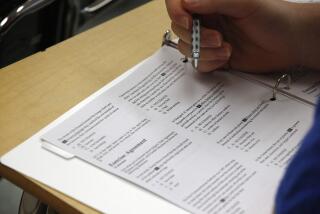State standardized test scores are out: What do they mean?

California’s statewide standardized test results came out Wednesday. Here is some background to help you make sense of the scores.
What tests are these?
The tests are known officially as the California Assessment of Student Performance and Progress. Some school administrators like to call it “CAASPP.” Others call it “Smarter Balanced,” after the name of the group that created the test.
What do these tests measure?
These tests are supposed to measure whether students in different grade levels are on track to be ready for college or their careers after high school. They are given to students in third through eighth grade and to 11th-graders. They cover English and math.
These tests are relatively new, and this is just the second year that students are receiving scores. With two years of data, this is the first time they can be compared from year to year to check on the progress a child or a school is making.
What are the tests based on?
The tests are based on the Common Core state standards, a set of learning goals for English and math that are supposed to prepare students for college. They are meant to be more challenging than former state standards and require an interactive method of learning and more critical thinking.
“This assessment is much more focused on higher order thinking skills than the old California test,” said Stanford education professor Linda Darling-Hammond, who helped develop the Smarter Balanced assessments.
On the old state tests, for example, a student might have been asked to answer a multiple-choice math question involving multiplication, Darling-Hammond said. But in the new tests, a student might be asked to use math to design a garden that requires a certain amount of space between vegetables.
How did my child do?
Although the statewide scores come out publicly this week, it is up to school districts to mail home individual student data. You should receive a document that tells you your child’s scores on the English and math exams, as well as how he or she performed last year. Here is a video from the state about how to read those scores:
Each student receives a score in English and in math, ranging from about 2,200 to about 2,700. (The numbers are slightly different depending on the grade and subject). Those scores are ranked in four categories: standard not met, standard nearly met, standard met and standard exceeded.
If your student is not meeting the standards, don’t panic.
“The standards are very high,” Darling Hammond said. “So it doesn’t mean that your child is falling off the cliff. What you should be looking for is how the child is moving over time and whether they are increasing their performance and increasingly approaching the standard.”
Also keep in mind that these tests are hardly the only indicators of a student’s success at school. Concerned parents should talk to their children’s teachers or principals about overall performance in the classroom, and find specific areas where they can improve, said Jo Ann Isken, the interim director of UCLA’s Teacher Education Program. They should also ask their schools what other resources, such as tutoring or after-school programs, might be available to help.
How did my child’s school do?
Experts warn that these standards are very high, and the test is relatively new so it is important to look at growth over time. Know that the annual school-wide scores are not as useful to compare as your child’s scores because they don’t necessarily measure the same students from year to year.
What are these scores used for?
Not much, yet. At some point, possibly within the next year, they will be one component of a larger school-accountability system aimed at determining how well schools are preparing students. The state has talked about such a system but hasn’t yet said what it might look like.
School districts also are supposed to take these scores into account when deciding how to spend money and dole out extra resources. Parents, by the way, are supposed to be a part of that decision-making process. So if you see a particular area that needs improvement at your child’s school, you can take it to the school’s administration and — if necessary— to the school board.
Times staff writer Ben Welsh contributed to this report.
Reach Sonali Kohli at Sonali.Kohli@latimes.com or on Twitter @Sonali_Kohli.
ALSO
More L.A. Unified students reach goals on statewide exams, district says
In a major win for teachers unions, California Supreme Court lets teacher tenure ruling stand
More than 400 new USC students are the first college-goers in their families
UPDATES:
Aug. 24, 11:21 a.m.: This article was updated to reflect that the scores have been released.
This article was originally published at 6:20 p.m. Aug. 23.
More to Read
Start your day right
Sign up for Essential California for news, features and recommendations from the L.A. Times and beyond in your inbox six days a week.
You may occasionally receive promotional content from the Los Angeles Times.







